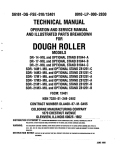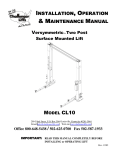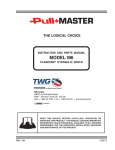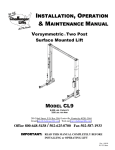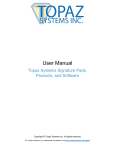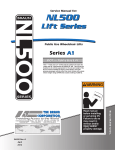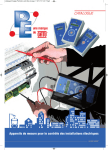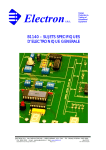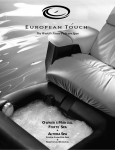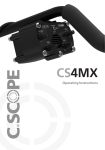Download USER GUIDE - Axis biodental
Transcript
USER GUIDE INNOVATING METAL-FREE IMPLANTOLOGY AXIS Implant System - User Guide 2 Index 1. Implant System 1 2. Pre-operative Planning 2 A. Indications & Contra-indications 2 B. Dimensions of Implants & Abutments 3 C. X-ray Template 3 3. Hexalobe Implant’s Operating Procedure 4 A. Surgical Procedure 4 i. Instruments Presentation 4 ii. Implant Site Preparation 6 iii. Implant Insertion 7 iv. Soft Tissue Management 10 v. Healing 10 B. Prosthetic Procedure 11 i. Impression 11 ii. Reconstruction 12 iii. Rehabilitation 14 4. Monobloc Implant’s Operating Procedure 15 A. Surgical Procedure 15 i. Instruments Presentation 15 ii. Implant Site Preparation 17 iii. Implant Insertion 18 iv. Healing 21 B. Prosthetic Procedure 21 i. Impression 21 ii. Reconstruction 21 iii. Rehabilitation 22 5. Implantation Follow-up 23 6. Cleaning - Sterilizing - Storage 24 7. Technical Support 25 Appendix 1: Rotation Speeds and Torques 26 Appendix 2: Labeling Explanations 27 www.axis-biodental.ch 3 AXIS Implant System - User Guide 4 1. Implant System 1 AXIS provides a non-metallic dental implant system. AXIS implants are available in two different versions: a screwed two-piece and a one-piece implant. AXIS Hexalobe Implants ref. A1079 ref. D1154 ref. A1080 ref. D1155 ref. D1157 3 8 10 12 ref. A1078 2 This two-piece implant is composed of an HIP Y-TZP zirconia fixture, a high performance polymer abutment and a prosthetic or holistic-gold screw. Straight 15° angled 15° angled abutment abutment A abutment B Hexalobe M8 Hexalobe M10 Hexalobe M12 Prosthetic screw Holistic screw ref. D1149 ref. D1047 4 AXIS Monobloc Implants This one-piece implant is made out of HIP Y-TZP zirconia. Monobloc M8 Monobloc M10 Monobloc M12 5 ref. A1076 6-7 Appendix ref. A1075 8 10 12 ref. A1074 www.axis-biodental.ch 1 AXIS Implant System - User Guide 2. Pre-operative Planning A. Indications & Contra-indications Indications Note The rule for choosing a dental implant is to use the one with the greatest diameter, with the resistance of that implant being proportional to the cube of its diameter. AXIS implants are especially indicated to replace a single tooth (1 tooth - 1 implant). Contra-indications General Contra-indications Contra-indication include, but are not limited to cardiovascular disease, uncontrolled diabetes, coagulation disorders (including taking anticoagulants), metabolic bone disease, chemotherapy or radiation treatment, chronic inflammation, metabolic or systemic disorders associated with lesions and/or bone healing, the use of pharmaceutical products that block or modify bone healing. Absolute Contra-indications Contra-indication include, but are not limited to uncontrolled para-functional diseases (bruxism, clenching or grinding of teeth), insufficient bone length or width, insufficient inter-arc gap, intraoral infection, insufficient coverage of the soft tissue and disorders that impede the ability of patients to maintain adequate oral hygiene. We may add other factors that can negatively influence success rates, such as smoking. 2 1 B. Dimensions of Implants & Abutments Note: Dimensions are in millimeters (mm). 3 2 4 C. X-ray Template An X-ray template is available (ref. I1098). It allows you to select the adequate implant length. X-Ray Template Ø4.0 0 2 4 6 8 10 12 0 2 4 6 8 10 12 110 % 100 % 0 2 4 6 8 10 12 0 2 4 6 8 10 12 0 2 4 6 8 10 12 140 % 130 % 120 % 0 2 4 6 8 10 12 0 2 4 6 8 10 12 0 2 4 6 8 10 12 150 % Ø4.0 Ø4.0 Ø4.0 6-7 Ø4.0 Ø4.0 Ø4.0 160 % Appendix Note: This X-Ray template can be used for one-piece implants as well as for two-piece implants. 5 Ø4.0 170 % I1098 - EN / 11-2011 © Axis biodental SA : All rights er served www.axis-biodental.ch 3 AXIS Implant System - User Guide 3. Hexalobe Implant’s Operating Procedure A. Surgical Procedure i. Instruments Presentation A sterilizable implantology kit (ref. B1085), containing all necessary instruments required to place AXIS implants is available. Torque wrench C1031 Wrench adapter C1030 Extension Screwdriver Implant Holder Round bur C1029 C1156 B1021/B1108 Pilot drill Gauge B1011 Drill S Drill M B1082 B1013 B1024 B1022 B1014 B1015 Attention All instruments must be sterilized before use. For sterilizing procedures, please refer to Section 6: Cleaning - Sterilizing - Storage. 4 Tap M Depth gauge M 1 In addition to the content of the surgical kit, other instruments are available. Tissue punch (ref. B1010) Profile Drill (ref. B1170) Point drill (ref. B1012) 2 Handpiece extension (ref. C1029) 3 Three tick marks indicating the working depth (8, 10 and 12 mm) have been etched on the instruments required for realizing the implant site. 4 12 mm 10 mm 8 mm Drill M 0,8 mm Pilot drill Gauge Drill S Drill M Depth gauge Tap 5 Working depth Important Appendix 6-7 In order to create optimal conditions for the integration of the implant, it is imperative to respect the recommended speeds and to apply a reasonable pressure during the site preparation. The respect of these rules will prevent over-heating which could slow or prevent the osseointegration of the implant due to bone necrosis. www.axis-biodental.ch 5 AXIS Implant System - User Guide 3. Hexalobe Implant’s Operating Procedure ii. Implant Site Preparation Osseous Crest Access Tissue punch (B1010) For accessing the bone, it is possible to use a scalpel or the tissue punch proposed by AXIS. A large round bur can be used to prepare the bone crest. Implant Site Preparation Round bur (B1011) Point drill (B1012) Mark the implant site using a round bur. The point drill can also be used at this stage. 1.4 mm round bur and point drill: max. 800 rpm Ø 2.4 mm Primary Drilling Pilot drill (B1013) Drill the implant site to the final depth using the pilot drill. Pilot drill: max 800 rpm Parallelism Control Direction indicator (B1022) Measure the depth of the site and assess its orientation using the direction indicator. Ø 2.9 mm Drilling Drill S (B1014) Widen the implant site using the S drill (yellow ring). Drill S: max 550 rpm Ø 3.4 mm Drilling Drill M (B1015) Widen the implant site using the M drill (red ring). Drill M: max 500 rpm Depth Control Depth gauge M (B1024) Measure the depth of the site using the M depth gauge (red ring). Ø 4.0 mm Tapping Tap M (B1082) For class I and II bone, tap the site using the tap M (red ring). Tap M: max 15 rpm and 35 Ncm Ø 4.5 mm Profile Drilling Profile drill (B1170) 6 If desired, the implant can be inserted deeper into the bone using the profile drill. Working depth indicated on the instrumentation are specific for transgingival implant positioning. When using the profile drill, the implant site should be 1.5 mm deeper. 1 iii. Implant Insertion Implant Unpacking Remove the blister from its packaging. 2 Each AXIS implant has its own article and batch number. To ensure the necessary tracking of products, this information must appear on the patient folder. For this purpose, labels are available on the blister of each implant. Remove the lid of the blister and deposit the inlay on a sterile surface. 3 Precautions The implant should not be placed in the mouth if the packaging is damaged or if the implant was in contact with a non-sterile surface. In this situation, the product must be replaced. Implant resterilizing is not allowed. 4 Packaging and sterilizing images (Appendix 2) Do not use if packing is damaged Do not reuse Appendix 6-7 5 Do not resterilize www.axis-biodental.ch 7 AXIS Implant System - User Guide 3. Hexalobe Implant’s Operating Procedure Gripping and Inserting the Implant Two types of protocols are available: - using the torque wrench (A), - using a right angle (B). Important Our Hexalobe implant holder has a mechanical fuse feature that prevents any over-torque application or irregular efforts. In case of misuse, the Hexalobe implant holder may break at the fuse level. In order to complete surgery despite an implant holder rupture, it is recommended to always have a second Hexalobe implant holder available. A. Protocol with the Torque Wrench Hexalobe implant holder (B1021) Connect the implant holder to the wrench adapter. Wrench adapter (C1030) Torque wrench (C1031) Hold the blister horizontally and connect the implant holder to the implant. Release the implant from its location by rotating it over its apical end. Note A cavity was created on the inlay to deposit, if necessary, the implant on a sterile surface. Start inserting the implant manually. Connect the torque wrench to the adapter. Screw the implant into the implant site until the end of the thread (see the opposite paragraph concerning Insertion Depth). Always keep the best possible alignment between instruments and implant. Implants should be screwed to a maximum torque of 35 Ncm. Note To avoid any damage to the implant, the implant holder breaks in case of improper use. 8 1 B. Protocol with the right angle Hexalobe implant holder (B1021) Connect the implant holder to the right angle. If necessary, use an handpiece extension. Handpiece extension Hold the blister horizontally and connect the implant holder to the implant. 2 (C1029) Release the implant from its location by rotating it over its apical end. 3 Note A cavity was created on the inlay to deposit, if necessary, the implant on a sterile surface. Screw the implant into the implant site until the end of the thread (see paragraph concerning Insertion Depth below). Note To avoid any damage to the implant, the implant holder breaks in case of improper use. 5 AXIS implants are transgingival. The implant’s neck should be approximately 1.5 mm above the bone crest. 6-7 1.5 They can also be inserted deeper into the bone using the profile drill. Appendix Insertion Depth 4 Always keep the best possible alignment between instruments and implant. Implants should be screwed to a maximum torque of 35 Ncm and a maximum speed of 15 rpm. Working depth indicated on the instrumentation are specific for transgingival implant positioning. When using the profile drill, the implant site should be 1.5 mm deeper. www.axis-biodental.ch 9 AXIS Implant System - User Guide 3. Hexalobe Implant’s Operating Procedure iv. Soft Tissue Management Several soft tissue management options are proposed: - Cover screw (A), - Cover screw (B), - Temporary abutment (C). A. Cover screw A cover screw is provided with each AXIS Hexalobe implant. It is located in the cavity of the blister sealed with a transparent lid. RA Screwdriver (C1156) Cover screw (D1145) Remove the lid and take the cover screw with the screwdriver. Suture the gingiva over the cover screw. In order to avoid failures, the cover screw must be tightened to a maximum torque of 15 Ncm. Cover screws are partially made out of PEEK which should not be used more than 180 days in the mouth. B. Healing abutment Depending of the case, gingiva formers are available in 2.5 mm or 4 mm height. RA Screwdriver (C1158) Healing abutments Use the screwdriver to tight the screw. Suture the gingiva around the implant collar (D1050, D1132) Prosthetic screw In order to avoid failures, the screw must be tightened to a maximum torque of 15 Ncm. Gingiva formers are made out of PEEK which should not be used more than 180 days in the mouth. (D1149) C. Temporary abutment RA Screwdriver (C1158) Prosthetic screw A temporary abutment is available. It allows a temporary restoration in aesthetic zone. (D1149) Temporary abutment (D1131) Use the screwdriver to tight the screw. Realize directly a temporary crown on the temporary abutment accordingly to the case and the standard method of the clinic. In order to avoid failures, the screw must be tightened to a maximum torque of 15 Ncm. Temporary abutments are made of PEEK which should not be used more than 180 days in the mouth. v. Healing The duration of soft tissue healing and osseointegration of AXIS’ implants vary generally from 2 to 4 months. It depends on the general state of health of the patient and the quality of the bone around the implant. It is possible to use standard means to control the osseointegration. 10 1 B. Prosthetic Procedure i. Impression RA Screwdriver (C1158) Exposing the implant connexion 2 Temporarily remove the soft tissue device. After exposing the implant connexion, choose either a clipped transfer (A) or an open tray transfer (B) to take an impression. A. Clipped transfer Hexalobe transfer cap clic Position and lock the hexalobe transfer cap on the implant. The cap will «click» when it is locked. 3 Positioning the transfer cap (D1040) Put light impression material around the cap and the implant and heavy impression material in the closed tray. Place the tray in the mouth, let it harden following the manufacturer’s recommendations, remove the tray. 4 Taking the impression Note Polyether or rubber polyvinylsiloxane based material are recommended for making quality impressions. 5 B. Open tray impression Positioning the transfer cap Position the transfer cap and tight it manually with the provided screw. 6-7 (D1152) Taking the impression Note Be sure that a corresponding perforation is made in the tray and that you can access the screw before the material hardens. Put light impression material around the cap and the implant and heavy impression material in the closed tray. Place the tray in the mouth, let it harden following the manufacturer’s recommendations, remove the tray. Loosen the screw to remove the tray. www.axis-biodental.ch Appendix Open tray transfer 11 AXIS Implant System - User Guide 3. Hexalobe Implant’s Operating Procedure ii. Reconstruction Making the Model Two options are available for the realization of the master-model: - Clipped transfer (A), - Open tray transfer (B). A. Clipped transfer Setting up the analog implant Hexalobe analog (D1042) clic Position and lock the analog in the impression tray. The analog implant will «click» when it is locked. Making the master model Make the master model following a standard method. B. Open tray impression Hexalobe analog (D1042) Setting up the analog implant Position the analog in the connexion transfer. Tight it manually. Making the master model Make the master model following a standard method. Plannification Laboratory abutments To choose the angulation of the restoration, straight and angulated 15° (version A and B) laboratory abutments are available. (D1158, D1159, D1160) Laboratory screw Note on difference between versions A and B abutments (D1084) Version A Angulation facing the lobe Version B Angulation facing the groove Making the Crown Abutments (D1154, Realize the crown following a standard method. D1155, D1157) Laboratory screwdriver (C1028) Notes To maintain the integrity of the master model, it is recommended to manually screw the elements using the AXIS screwdriver (ref. C1028). Laboratory screws (ref. D1084) are green and are only dedicated for laboratory use. They should not be used by a clinician. Attention Each implant must replace a single tooth and support a single crown. 12 1 Implant-Crown Assembly 2 To ensure a perfect sealing and an optimal mechanical resistance, the crown must stands on the implant collar. If it is necessary, only the green area, highlighted on the left-hand side figure, can be modified. Modification forbidden Minimal height: 3 mm Please note that only one abutment height is available. Abutments are made out of High performance polymer easily adjustable. Such changes are under the responsibility of the practitioner and the prosthetist. If the abutment has not been modified, a positioning key is not necessary, the abutment being multi-symetric. 5 Scanning 4 Modification allowed Maximal height: 5 mm 3 Modification of the Abutment Appendix 6-7 Most of standard scanning techniques can be used with AXIS implants. For further information, please refer to manufacturer’s instructions. www.axis-biodental.ch 13 AXIS Implant System - User Guide 3. Hexalobe Implant’s Operating Procedure iii. Rehabilitation Final Abutment Set Up Prosthetic screw (D1149) RA Screwdriver (C1158) Disinfection Before rehabilitation, neutral disinfectants (no chlorine, ammonia, or aldehyde) should be used according to manufacturers’ recommendations for disinfecting prosthetic parts. Unscrew the soft tissue management device. Place the abutment on the implant and lock it with a new screw. Important For rehabilitation, only use a new screw. Laboratories screw are green and are not suitable for implantation. In order to avoid failures, prosthetic screw must be tightened at a maximum torque of 25 Ncm. Holistic screw must be tightened at a maximum torque of 15 Ncm. Crown Sealing Comments Before sealing the prosthetic part, it is necessary to seal the screw’s well with a material like Teflon, gutta-percha or cotton. Do not use resin. Seal the previously disinfected crown on the abutment. Ideally, use a MDP resin-type adhesive. Please refer to the instructions provided by the manufacturer. 14 4. Monobloc Implant’s Operating Procedure 1 A. Surgical Procedure i. Instruments Presentation 2 A sterilizable implantology kit (ref. B1085), containing all necessary instruments required to place AXIS implants is available. Torque wrench 3 C1031 Wrench adapter C1030 Extension Screwdriver Round bur C1029 C1156 Gauge B1011 Drill S Tap M Depth gauge M B1021/B1108 Pilot drill 4 Implant Holder Drill M B1082 B1013 B1024 B1014 B1015 5 B1022 Appendix All instruments must be sterilized before use. For sterilizing procedures, please refer to Section 6: Cleaning - Sterilizing - Storage. 6-7 Attention www.axis-biodental.ch 15 AXIS Implant System - User Guide 4. Monobloc Implant’s Operating Procedure In addition to the content of the surgical kit, other instruments are available. Tissue punch (ref. B1010) Rofile drill (ref. B1170) Point drill (ref. B1012) Handpiece extension (ref. C1029) Three tick marks indicating the working depth (8, 10 and 12 mm) have been etched on the instruments required for realizing the implant site. 12 mm 10 mm 8 mm 0,8 mm Drill M Pilot drill Gauge Drill S Drill M Depth gauge Tap Working depth Important In order to create optimal conditions for the integration of the implant, it is imperative to respect the recommended speeds and to apply a reasonable pressure during the site preparation. The respect of these rules will prevent over-heating which could slow or prevent the osseointegration of the implant due to bone necrosis. 16 1 ii. Implant Site Preparation Osseous Crest Access Tissue punch (B1010) For accessing the bone, it is possible to use a scalpel or the tissue punch proposed by AXIS. 2 A large round bur can be used to prepare the bone crest. Implant Site Preparation Round bur (B1011) Point drill (B1012) Mark the implant site using a round bur. The point drill can also be used at this stage. 1.4 mm round bur and point drill: max. 800 rpm 3 Ø 2.4 mm Primary Drilling Pilot drill (B1013) Drill the implant site to the final depth using the pilot drill. Pilot drill: max 800 rpm Direction indicator (B1022) Measure the depth of the site and assess its orientation using the direction indicator. 4 Parallelism Control Ø 2.9 mm Drilling Drill S (B1014) Widen the implant site using the S drill (yellow ring). Drill S: max 550 rpm Drill M (B1015) 5 Ø 3.4 mm Drilling Widen the implant site using the M drill (red ring). Drill M: max 500 rpm Depth gauge M (B1024) Measure the depth of the site using the M depth gauge (red ring). 6-7 Depth Control Tap M (B1082) For class I and II bone, tap the site using the tap M (red ring). Tap M: max 15 rpm and 35 Ncm Ø 4.5 mm Profile Drilling Profile drill (B1170) Appendix Ø 4.0 mm Tapping If desired, the implant can be inserted deeper into the bone using the profile drill. Working depth indicated on the instrumentation are specific for transgingival implant positioning. When using the profile drill, the implant site should be 1.5 mm deeper. www.axis-biodental.ch 17 AXIS Implant System - User Guide 4. Monobloc Implant’s Operating Procedure iii. Implant Insertion Implant Unpacking Remove the blister from its packaging. Each AXIS implant has its own article and batch number. To ensure the necessary tracking of products, this information must appear on the patient folder. For this purpose, labels are available on the blister of each implant. Remove the lid of the blister and deposit the inlay on a sterile surface. Precautions The implant should not be placed in the mouth if the packaging is damaged or if the implant was in contact with a non-sterile surface. n this situation, the product must be replaced. Implant resterilizing is not allowed. Packaging and sterilizing images (Appendix 2) Do not use if the packaging is damaged Do not reuse Do not resterilize 18 Gripping and Inserting the Implant 1 Two types of protocols are available: - using the torque wrench (A), - using a right angle (B). A. Protocol with the Torque Wrench Connect the implant holder to the wrench adapter. 2 Monobloc implant-holder (B1108) Wrench adapter (C1030) Hold the blister horizontally and connect the implant holder to the implant. Torque wrench (C1031) Note A cavity was created on the inlay to deposit, if necessary, the implant on a sterile surface. 3 Release the implant from its location by rotating it over its apical end. 4 Start inserting the implant manually. 5 Connect the torque wrench to the adapter. Always keep the best possible alignement between instruments and implants. Implants should be screwed to a maximum torque of 35 Ncm. 6-7 Screw the implant into the implant site until the end of the thread (see the opposite paragraph concerning Insertion Depth). Appendix Remove the instruments and suture the gum. www.axis-biodental.ch 19 AXIS Implant System - User Guide 4. Monobloc Implant’s Operating Procedure B. Protocol with the right angle Monobloc implant-holder (B1108) Connect the implant holder to the right angle. If necessary, use an handpiece extension. Handpiece extension (C1029) Hold the blister horizontally and connect the implant holder to the implant. Release the implant from its location by rotating it over its apical end. Note A cavity was created on the inlay to deposit, if necessary, the implant with the implant holder on a sterile surface. Screw the implant into the implant site until the end of the thread (see paragraph concerning Insertion Depth below). Always keep the best possible alignment between instruments and implants Implants should be screwed to a maximum torque of 35 Ncm and a maximum speed of 15 rpm. Remove the instruments and suture the gum. Insertion Depth Monobloc AXIS implants are transgingival. The implant’s neck should be approximately 1.5 mm above the bone crest. 1.5 They can also be inserted deeper into the bone using the profile drill. Working depth indicated on the instrumentation are specific for transgingival implant positioning. When using the profile drill, the implant site should be 1.5 mm deeper. 20 To avoid loading the implant during osseointegration, AXIS biodental recommends achieving temporary rehabilitation in under-occlusion mode. 1 iv. Healing It is possible to use standard means for the control of osseointegration. 2 The duration of soft tissue healing and osseointegration of AXIS’ implants vary generally from 2 to 4 months. It depends on the general state of health of the patient and the quality of the bone around the implant. B. Prosthetic Procedure i. Impression clic Positioning the transfer cap 3 Monobloc transfer cap (D1036) Position and lock the transfer cap on the implant. The cap will «click» when it is locked. Put light impression material around the cap and the implant and heavy impression material in the closed tray. 4 Taking the impression Place the tray in the mouth, let it harden following the manufacturer’s recommendations, then remove the tray. 5 Note Polyether or rubber polyvinylsiloxane based material are recommended for making quality impressions. ii. Reconstruction Setting up the analog implant Monobloc analog Position and lock the analog implant in the impression tray. The analog implant will «click» when it is locked. Making the master model Make the master model following a standard method. www.axis-biodental.ch Appendix clic 6-7 (D1037) 21 AXIS Implant System - User Guide 4. Monobloc Implant’s Operating Procedure Making the Crown Make the crown following a standard method. It is recommended to sandblast the abutment in order to increase the adhesion of the crown. Attention Each implant must replace a single teeth and support a single crown. Implant-Crown Assembly For mechanical reasons and to ensure the sealing, the crown must stands on the implant chamfer. Modification of the Abutment Modification allowed Maximal height: 2,5 mm Modification forbidden Minimal height: 2,5 mm AXIS recommends not modifying the abutment. However, if it is necessary, only the green area, highlighted on the left-hand side figure, can be modified. The modification of the abutment must be made with a fine diamond bur under irrigation and with moderate pressure in order to avoid heating the material and generating micro-cracks. Such changes are the responsibility of the practitioner and the prosthetist. Scanning Most of standard scanning techniques can be used with AXIS implants. For further information, please refer to manufacturer’s instructions. iii. Rehabilitation Crown Sealing Comments Neutral disinfectants (no chlorine, ammonia, or aldehyde) should be used according to manufacturers’ recommendations for disinfecting prosthetic parts. Seal the previously disinfected crown on the abutment. Many adhesives for the bonding of zirconium oxide are available on the market. Ideally, sandblast the abutment and use a MDP resin-type adhesive. Please refer to the instructions provided by the manufacturer. 22 5. Implantation Follow-up 1 To prevent any problems, regular clinical follow-up is recommended. Ideally, the tracking should be realized by the clinician in charge of the implantation. After implantation: Inform the patient on the post-operative procedure in case of any problem. Draw the patient’s attention to the importance of a good dental hygiene and its influence on the implantation success. 2 The follow-up, proposed here-under, must be adapted accordingly to the clinical history of each patient. After rehabilitation: 6 months after rehabilitation, a follow-up visit will ensure the perfect behavior of the implant. Inform the patient about the importance of communicating all problems encountered (discomfort, ache...). Long term: It is recommended to realize an annual X-ray. More controls could be necessary for A good follow-up, ensured by a dentist and/or a dental hygienist, as well as a good dental hygiene, are necessary conditions for the long-term success of an implantation. 3 high risk patient, suffering from parodontitis for example. Appendix 6-7 5 4 As for natural teeth, implants are exposed to influences of the buccal cavity: dental plaque, tartar, bacteria... In case of insufficient care, complications (inflammation, bleeding...) can lead to the loss of the implant. www.axis-biodental.ch 23 AXIS Implant System - User Guide 6. Cleaning - Sterilizing - Storage All devices entering into direct contact with the patient should be sterilized prior to use Exceptions: - Products clearly identified as sterile (implant with the cover screw). - Abutments and crowns must be decontaminated prior to use with a low or intermediate EPAregistered hospital disinfectant. Strictly follow manufacturer’s instructions. Non-sterile components should be removed from their original packaging prior to sterilizing. Cleaning and sterilizing of these components before their first use is under the responsibility of the clinician. Sterilizing Steps Decontamination: Put the instruments in a disinfectant solution immediately after use. Do not let the contaminated instruments dry. Cleaning and disinfection: Disassemble the instruments that can be taken apart (torque wrench). Group components according to their composing materials in order to avoid electrolysis and corrosion. Submerse them in a disinfectant: - Cleaning solutions with high chlorine content or oxalic acid are inappropriate for the cleaning of stainless steel instruments (risk of corrosion) - Alkaline products with a pH higher than 9 are inappropriate for cleaning tools made of anodized aluminum (risk of deteriorating the surface). Cleaning can be done manually or mechanically (by ultrasound). Be careful to dry the parts with clean compressed air. Inspection: Check for cleanliness and proper function of instruments and components. Reassemble the disassembled instruments. Replace damaged instruments. To ensure optimal performance, the rotating equipment should not be used more than 10 times. Packaging: The instruments can be packaged individually or inserted in their dedicated location in the implantology kit, which will be then packed before sterilizing. Sterilizing: Chemical and hot air sterilizing are inappropriate. Sterilizing by saturated steam is recommended using the following parameters: 134 °C during 18 minutes. The recommended drying time should be between 20 to 60 minutes. For components sterilized at dental practice, the validity depends on various factors such as material used for packing, storage conditions... refer to standard procedure of the dental practice. For sterile delivered components, an expiration date is indicated on the labelling (see Appendix 2). No component must be used beyond the expiration date. Storage: Store the bags in a clean and dry place. 24 7. Technical Support 1 What is to be done in case of problem or if you have any question? In case of problems or if you have any questions, please contact your local representative (agent, distributor, ...). Note: Before anything else, be sure to clean the implant connection and remove any fragments. Point driver (1A) Realization of a drilling point Insert the point driver (1A) into the implant connection and insert the pointer (1B) with no speed until it is in contact with the screw. Put the driver in counterclockwise rotation at 800 rpm during approximately 10 seconds while exercising a moderate pressure. Remove the driver and the pointer. Pointer (1B) Extraction drill driver (2A) 3 Prosthetic screw extraction kit (C1122): If the prosthetic screw breaks, a part may get stuck inside the implant. A Prosthetic screw extraction kit is dedicated to the removal of the rest of the screw without damaging the implant. This kit is composed of a point drill, a drill, an extractor and two guide rings. It is available under reference C1122 for titanium screw and under C1166 for holistic screw. Drilling the screw Extraction drill (2B) Insert the extraction drill driver (2A) into the implant and introduce the extraction drill (2B) with no speed until it is in contact with the screw. Put the drill in counterclockwise rotation at 1’000 rpm, drill up to the stop and remove the instrument always in rotation. Remove the driver. Note: it is possible that the screw comes already out at this stage Helicoidal extractor (3) 4 Wrench adapter (C1030) 2 Breaking of the Prosthetic Screw Be sure to use all these instruments counterclockwise. Always keep the best alignment between instruments and implant, even with a guide ring. 6-7 Assemble the helicoidal extractor (3) and the adapter. Place the extractor in the hole previously realized in the screw. Then turn manually counterclockwise by exercising a moderate pressure to bind the extractor in the hole. 5 Screw extraction Trephine Ø4.0mm (B1144) Trephine Ø4.5mm (B1143) For removing an osseointegrated implant, use the trephine. When using the trephine, apply moderate pressure and do not exceed 800 rpm in order to prevent bone overheating. All items that have been removed are recommended to be placed in a buffer solution containing 10% Neutral Buffered Formalin for proper preservation. To perform tests and analysis required, please contact your local representative. www.axis-biodental.ch Appendix Breaking of the Implant 25 AXIS Implant System - User Guide Appendix 1 - Rotation Speeds & Torques Device Instrument 26 Maximal speed (rpm) Maximal torque (Ncm) Designation Reference Implant A1078-1080 15 35 Monobloc implant A1074-1076 15 35 Prosthetic screw D1047 / 25 Holistic prosthetic screw D1165 / 15 Laboratory screw D1050 / manually Maximal speed (rpm) Designation Reference Tissue punch B1010 800 Round bur B1011 800 Point drill B1012 800 Pilot bur B1013 800 Drill S B1014 550 Drill M B1015 500 Tap M B1082 15 Profile drill B1170 300 Trephine Ø4 B1144 800 Trephine Ø4.5 B1143 800 RA screwdriver C1156 / Laboratory screwdriver C1028 / Hexalobe holder B1021 / Monobloc holder B1108 / Appendix 2 - Labelling Explanations Instrument Label 2 1 Implant Label 3 Symbol Explanation CE marking Manufacturer 4 Expiration date Batch number Reference Non-sterile 5 Sterile Caution - Read the instructions for use Information - Read the instructions for use 6-7 Do not resterilize Do not reuse Do not use if the packaging is damaged Maximal speed (clockwise or anti-clockwise rotation) Appendix Keep away from direct sunlight Maximal torque (clockwise rotation only) www.axis-biodental.ch 27 I1062-EN - v.11/13 AXIS biodental SA Les Rosées 5 - 2336 Les Bois - Switzerland Tél. +41 (0)32 961 10 90 - Fax +41 (0)32 961 18 66 - [email protected] - www.axis-biodental.ch
































